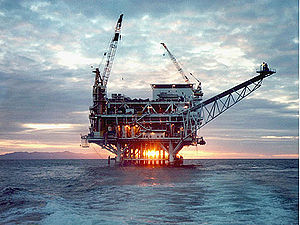
The United States offshore drilling debate is an ongoing debate in the United States about whether, the extent to which, in which areas, and under what conditions, further offshore drilling should be allowed in U.S.-administered waters.

The issue saw increased coverage when President George W. Bush, in July 2008, lifted a 1990 executive order by his father, President George H. W. Bush, banning offshore drilling,[1] and calling for drilling in the Arctic National Wildlife Refuge.[2]
The issue of offshore drilling became central in the 2008 presidential election, not least because of the oil price increases since 2003. It is also being debated in terms of both environmental issues and U.S. energy independence. As of September 2008, President Barack Obama was for limited offshore drilling as part of an extensive energy independence overhaul.[2]
Bush's energy policy was named "drill and veto" by U.S. House Speaker Nancy Pelosi.[3] The Drill Responsibly in Leased Lands (DRILL) Act (H.R. 6515) is one of the bills discussed in the Congress about drilling.[4] In Florida, many counties, cities, chambers of commerce, and other local agencies have passed resolutions against oil drilling in Florida waters.[5]
On March 31, 2010, President Obama announced that he was opening new areas in U.S. coastal waters to offshore drilling for gas and oil.[6][7] This was in stark contrast to his reaction only a few weeks later to the Deepwater Horizon explosion and Deepwater Horizon oil spill in the Gulf of Mexico that became the biggest environmental disaster in US history.[8] In November 2010, the Obama administration rescinded the decision to open new areas.[9]
- ^ "Bush lifts executive ban on offshore oil drilling". CNN. 2008-07-14. Retrieved 2008-09-27.
- ^ a b Johanna Neuman; Richard Simon. "Bush 43 urges offshore drilling that Bush 41 banned". Los Angeles Times. Retrieved 2008-09-27.
- ^ "Pelosi: Bush Administration's Energy Policy is 'Drill and Veto'". United States House of Representatives. Archived from the original on 2008-08-02. Retrieved 2008-09-27.
- ^ "Congressional Action on Gas Prices & Energy Independence". Nancy Pelosi. Archived from the original on 2008-10-02. Retrieved 2008-09-27.
- ^ Map of Resolutions Passed Against Offshore Oil Drilling in Florida http://www.google.com/maps/ms?ie=UTF8&hl=en&msa=0&msid=106172446447503097421.000480838fe1fe5d92709&z=6
- ^ Juliet Eilperin and Anne E. Kornblut (April 1, 2010). "President Obama opens new areas to offshore drilling". The Washington Post.
- ^ John M. Broder (March 30, 2010). "Obama to Open Offshore Areas to Oil Drilling for First Time". The New York Times.
- ^ Kristi Keck (May 3, 2010). "Could oil spill sap appetite for Obama's offshore drilling plans?". CNN.
- ^ John M. Broder and Clifford Krauss (December 1, 2010). "U.S. Halts Plan to Drill in Eastern Gulf". New York Times.